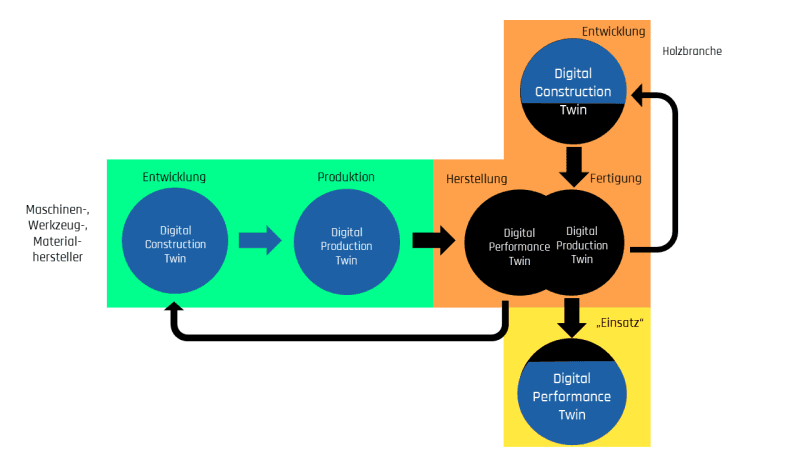Manchmal habe ich den Eindruck, dass heute schon Ostern ist, jeder ist auf der Suche nach DEM digitalen Zwilling. Wie innovativ ein Unternehmen doch ist, wenn es den digitalen Zwilling zu einem Produkt entwickelt hat. Aber was ist das nun, dieser digitale Zwilling?
Den einen digitalen Zwilling gibt es nicht. Alle datenerzeugten Beschreibungen eines physikalischen oder virtuellen Objektes können als digitaler Zwilling verstanden werden. Im einfachsten Fall kann es ein Textdokument sein, indem ein Objekt beschrieben wird. In weiterführenden Fällen enthalten Digitale Zwillinge aber auch Modelle, Simulationen und Algorithmen, die dazu beitragen das Verhalten des realen Assets zu beschreiben.
Einsatz von digitalen Zwillingen in tapio
Grundsätzlich betrachten wir unsere Branche aus zwei Perspektiven. Die erste Perspektive ist die Sicht von Herstellern von Objekten für eine Produkten (z.B. Maschinen-, Werkzeug- oder Materialhersteller). In der Regel ist das die Perspektive unserer tapio Business Partnern. Diese Partner erzeugen heute meistens physikalische Güter, die in der Holzbranche Verwendung finden und von ihren Kunden benutzt werden. Kunden sind all diejenigen die sich in irgendeiner Art und Weise an der Wertschöpfungskette von einem Baum im Wald bis zum fertigen Möbelstück, Fenster, Fußboden oder Bauteilen für Ihr Haus beteiligen. Also Möbelproduzenten, Fertighausproduzenten oder Fußbodenproduzenten. Die Liste lässt sich ewig fortführen.
In der ersten Perspektive der Partner wird der Lebenszyklus einer Maschine, eines Werkzeuges oder eines Verbrauchsmaterials betrachtet. Hierbei entwickeln all diese Partnerunternehmen ihre Produkte in ihren eigenen Firmen. Hierbei werden Maschinenteile konstruiert, Schneiden verbessert oder Rezepturen entwickelt. Dieser Vorgang wird in den Entwicklungsabteilung immer mit Hilfe von digitalen Zwillingen durchgeführt. Man denke an die CAD-Zeichnungen, die Zerspanmodelle oder auch Versuchsberichte zu chemischen Experimenten. All diese Daten können in einem digitalen Zwilling zusammengefasst werden. Im Rahmen des tapio Kontextes heißen diese Zwillinge „Digital Construction Twins“. Sobald die Produkte fertig entwickelt sind, werden diese Assets produziert. Hierbei schauen wir in die Produktionshallen der Maschinenbauer, Werkzeughersteller oder Kantenbandproduzenten. Während des Herstellungsprozesses müssen zur richtigen Zeit Teile gefräst werden, Grundmaterialien bereitgestellt werden und Komponenten richtig montiert werden. Während dieses Prozesses von Logistik, Produktionssteuerung bis zu der Inbetriebnahme werden Informationen zu jedem Produkt digital hinterlegt und benutzt. Je nach digitalem Reifegrad sprechen wir hier von einer Industrie 4.0 Produktion. Die abgelegten oder erzeugten Daten im Produktionsprozess nennen wir „digital production twin“.
Nach der Qualitätskontrolle und Versendung des Produkts zum Kunden geht auch der Besitz des Digitalen Zwillings an den Kunden über. Dieser nimmt z.B. die Maschinen in Empfang und benutzt diese in seiner eigenen Möbelproduktion.
Hier ändern wir die Perspektive zur Sicht unserer Kunden (z.B. Möbelproduzenten). Denn auch er beginnt immer mit der Entwicklung seiner eigenen Produkte wie z.B. einer Küche, eines Fußbodens oder eines Fensters. Das Grundkonzept wie ein Produkt entsteht wird entweder auftragsbezogen oder unabhängig von einem Auftrag als Produkt angelegt. Und auch hier entstehen Daten welche in einem digitalen Zwilling gespeichert werden. Und auch hier sprechen wird von einem „digital construction twin“ allerdings gehört dieser in das Unternehmen unseres Kunden. Wenn der digital construction twin eines Möbelherstellers nun den Weg in die Produktion findet wird ebenfalls aus dem construction twin ein production twin.
Jetzt kommt der spannende Moment wo sich die beiden Sichtweisen des tapio Partners und des Kunden in der Kundenproduktion treffen: Die Maschine wird benutzt, um das Produkt unseres Kunden herzustellen. Beide physischen Objekte, Maschine und Möbelstück, besitzen digitale Zwillinge und beide Zwillinge müssen getrennt von einander betrachtet werden. Der Maschinenhersteller möchte gerne z.B. mit Hilfe des Internets der Dinge mehr Informationen über die Lebensdauer seines Produktes bekommen. Dies geschieht über das tapio Datenreferenzmodells (tadamo) welches wir für unsere Partner und Kunden zur Verfügung stellen. Ein tadamo ist auf die Bedürfnisse der Holzbranche hin entwickelt und bietet den Partnern und Kunden die Möglichkeit den Digitalen Zwilling der Maschinen oder des Werkzeugen in der Produktion der Holzbranche zu benutzen. Wir sprechen hier von einem „digital performance twin“ eines Assets.
Das eigentliche Produkt des Kunden z.B. eine individualisierte Küche und deren einzelne Bauteile werden ebenfalls in digitalen Zwillingen (hier wieder „digital production twins“ durch die Fertigung begleitet.
Somit befinden sich in der Produktionshalle unserer Kunden immer mindestens 2 digitale Zwillinge: Der digital performance twin der Maschine und der digital production twin des Möbelstücks. Beide haben unterschiedliche Eigenschaften und Ziele, jedoch können beide mit Hilfe des tapio Datenreferenzmodells abgebildet werden.
Sobald das Möbelstück nun zum Endkunden verkauft wird besitzt es aus Sicht des Möbelherstellers wiederum einen digital Performance twin, welche die Lebensdauer des Möbelstücks beim Endkunden beschreibt. Dieser Ansatz ist aktuell noch eher eine Vision, allerdings kann das Internet der Dinge dazu führen, dass wir die Lebensdauer unserer Möbel mit Hilfe von Sensoren aufzeichnen oder die Möbelstücke selbst immer intelligenter werden. Denken Sie nur an den Lattenrost im Bett, welcher mit Hilfe einer Smartphone App in der Lage ist die Kopfstützeneinstellung zu ändern.
Digitale Zwillinge sind grundsätzlich als Fundament für eine sinnvolle Nutzung des IoT zu sehen. Zudem werden die Informationen aus digitalen Zwillingen benutzt, um echte Industrie 4.0 Anwendungen umzusetzen. tapio bietet mit Hilfe des tadamo einen umfänglichen Ansatz, die Holzbranche in ausreichender und bewusst nicht vollumfänglicher Form zu beschreiben. Möbelhersteller sowie Maschinen-, Werzeug- und Materialhersteller benutzen tadamo um ihre Ansätze für eine digitale Holzbranchen umzusetzen.
















